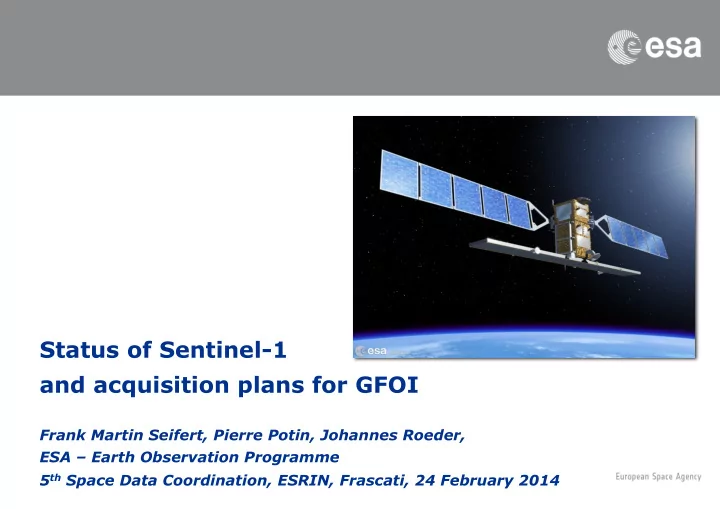

Status of Sentinel-1 and acquisition plans for GFOI Frank Martin Seifert, Pierre Potin, Johannes Roeder, ESA – Earth Observation Programme 5 th Space Data Coordination, ESRIN, Frascati, 24 February 2014
GMES Sentinel Missions Sentinel 1 – SAR imaging All weather, day/night applications, interferometry 3 April 2014 (A), 2015+ (B) Sentinel 2 – Multispectral imaging Land applications: urban, forest, agriculture,.. Continuity of Landsat, SPOT Spring 2015 (A), 2016 (B) Sentinel 3 – Ocean and global land monitoring Wide-swath ocean colour, vegetation, sea/land surface temperature, altimetry 2015 (A), 2016 (B) Sentinel 4 – Geostationary atmospheric Atmospheric composition monitoring, trans- boundary pollution 2018 Sentinel 5 and Precursor – Low-orbit atmospheric Atmospheric composition monitoring 2015 (5P), 2019
Sentinel-1 Mission Facts • Constellation of two satellites (A & B units) • C-Band Synthetic Aperture Radar Payload (at 5.405 GHz) • 7 years design life time with consumables for 12 years • Near-Polar sun-synchronous (dawn-dusk) orbit at 698 km • 12 days repeat cycle (1 satellite), 6 days for the constellation • Both Sentinel-1 satellites in the same orbital plane (180 deg phased in orbit) • Optical Communication Payload (OCP) for data transfer via laser link with the GEO European Data Relay Satellite (EDRS) • Launch of Sentinel-1A scheduled for 3 April 2014 (Sentinel-1B ready for launch by end 2015)
Sentinel-1 SAR Imaging Modes 4 mutually exclusive SAR modes with different resolution and coverage • Polarisation schemes for IW, EW & SM: ü single polarisation: HH or VV ü dual polarisation: HH+HV or VV+VH • Wave mode: HH or VV • SAR duty cycle per orbit: ü up to 25 min in any of the imaging modes ü up to 74 min in Wave mode Main modes of operations: - IW over land and coastal waters - EW over extended sea and sea-ice areas - WV over open oceans
SENTINEL-1 STATUS QAR KO (Satellite Sentinel-1A major milestones Qualification Review) à January 13 th , 2014 QAR Conclusion à February 18 th , 2014 Shipment to Kourou à February 21 st , 2014 Launch Campaign Start à February 24 th , 2014 Launch à March 28 th , 2014 IOCR (Satellite In-Orbit Commissioning Review à July, 2014
SENTINEL-1 Observation Concept Overview - Mission Ramp-Up
Sentinel-1 Observation Scenario Objective In line with the Sentinel operations strategy objectives: à Implement a pre-defined and conflict-free observation plan, aiming at fulfilling, to the best extent, the observation requirements from: - the Copernicus services - the use by ESA / EU Member States à In addition, on best effort basis: - ensure continuity of ERS/ENVISAT - implement requirements from the science community - contribute to international cooperation activities. à Need to find a priori the solutions on the potential conflict among users (e.g. different SAR operation modes / polarisation required over same geographical area) 7 7 1 1 1 ¡ 8 8 1 ¡ 5 9 7 1 3 5
Collecting the Sentinel-1 Observation Requirements Group Source of Requirements Copernicus services and - Extrapolation of Copernicus Data Access Data Warehouse Copernicus use requirements - Direct discussions with Copernicus services and EU Agencies (e.g. EMSA) National services and use - Discussions with Member States Delegations by ESA and EU Member - Reply to Collaborative Ground Segment questionnaire (in the States framework of the GOCG) Scientific use, on-going - Recommendations from scientists at key SAR workshops projects, continuity of (FRINGE, SEASAR), and others ESA organised workshop (e.g. ERS/ENVISAT SEN4SCI, Cryosphere, Int. Forum on Geohazards, etc.) - ESA GSE Projects (e.g. Polar View, MARISS, Terrafirma, GMFS, etc.) - Glob-series projects, CCI, SEOM, etc. - Extrapolation of ERS/ENVISAT projects International Initiatives, - GEO/CEOS (e.g. GFOI, GEOGLAM, Geo-hazard Supersites), International cooperation IGOS, FAO, REDD+, PSTG, IICWG, GCOS, CliC, TIGER, DRAGON, etc. - Requests from international partners (e.g. US (NOAA / NASA / USGS), Australia, China, etc.) Other use including use for EARSC, etc. commercial value-adding
SENTINEL-1 MISSION RAMP-UP Sentinel-1 mission operations is characterized by phases: A gradual ramp-up allowing adapting the Sentinel-1 exploitation capacity to the • increasing needs of the users while optimizing the available resources Progressive evolution in the availability of the overall system, the data • throughput and timeliness, the committed services to users
Sentinel-1 gradual capacity increase: data download & sensing time
GFOI Request to Sentinel-1 Dual-pol IW mode: VV/HV • Consistent and systematic acquisitions • Simulate coverage 4 times a year • Acquire tectonic data sets in the tropics with dual–pol, e.g. Latin • America Prioritize areas with heavy cloud coverage • High interest by some countries for early detection of forest • disturbances – “Early Warning” – with frequent coverage need.
GFOI Input to Sentinel-1 HLOP Latin America: Southern Mexico • Ecuador (new input after SDCG-4) • Colombia (whole, Pacific region, Amazon region more frequent ~ monthly) • Peru • Xingu (Brazil) - continuation of Envisat observations as development test bed • Africa: a larger part of Tanzania (whole, with preference west and / or south) • any part in the Congo Basin ( Cameroon, DRC, Rep of Congo, Gabon, ...) • Asia: Indonesia ( Sumatra , best whole, but also Western / Eastern half of the island, • otherwise/and parts of Borneo ) Mekong area with Viet Nam, Cambodia, ... •
Indicative observations plan for cycles 1 and 2 after IOCR Acquisitions over 1 repeat cycle !
Sentinel-1 Acquisitions related to GFOI during ramp-up phase in South America
Gradual provision of qualified products Slide 15 !
Summary • Launch of Sentinel-1A: 3 April 2014 • 3 months commissioning phase ( è è 10% duty cycle) • 9 months ramp-up phase ( è è 25% duty cycle) • Priority for Copernicus and National services (ESA and EU) • Inclusion for early acquisitions of GFOI requests in Latin America and South East Asia during ramp-up phase • More difficult for Africa • Gradual provision of Sentinel-1 products to users after commissioning phase
Recommend
More recommend